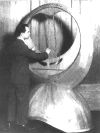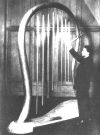Fired
by that idea,
he did not stop with the Lyre,
but evolved other instruments
by metamorphoses of form:
Smaller and larger arches of
Tubular Bells, up to more than
2 1/2 metre high were designed,
sets of bellshaped Bells in
wooden stands or hand-held
frames, types of Xylophone,
a lute-shaped wooden Kettledrum,
a Tao-lyre with a shape
all of its own, born from
Rudolf Steiner's indications
for meditations in music.
He wrestled also with ideas
for other kinds of string
and wind instruments.
A fully-fledged
Concert String
Instrument and more ...... As the large
family
of Lyre shapes might
indicate, the Lyre
and its further development
became Lothar Gärtner's chief
concern and lifework.
Of all the instruments
this one found the
greatest echo and response.
First at Dornach
and Arlesheim, in the
vicinity of the Goetheanum,
then throughout the world
circles of Lyre playing
musicians began to form, |
fostering musical
activities and
the development
of this instrument.
Classic compositions
or music arranged
for the Lyre began
to appear. In such
circles the Lyre is
played Solo, in
Ensemble or as
a whole orchestra
and it is often used
together with the
human voice or other
instruments and has
now a firmly
established place as a
concert instrument.
But due to its intimate
musical quality, the
Lyre was soon
recognised to be
eminently suitable in
the realm of
educational or
therapeutic work, as it
had indeed been
originally intended by
Edmund Pracht. Hence
music therapists,
remedial teachers,
teachers and
Kindergarten teachers
value this instrument
in particular
From the beginning
to today Since 1926
and the partnership
of W.Lothar Gärtner
and Edmund Pracht
in Dornach
Switzerland, the
making of the Lyre
grew via a simple
workshop into the
well equiped Master
Workshop of today |
Already as
early as 1938 W.Lothar
Gärtner established
the Master title specific
to Lyremaking when
he was the first to
pass such a Master
Examination. His son
followed in the family
tradition, and as
Master and director of
the firm from 1980 first
ran the business with
his mother Elisabeth
Gärtner, herself a
Music Teacher and
Eurythmsit, and later
on with his wife
Karin Gärtner.
Masterbuilt quality We believe
the Gärtner Lyres
remain unequalled in
form, execution,
material selection,
workmanship and
sound quality,
although there are
many copies and
similar instruments. In
short, they are the
original Lyre, built by
master hands. Many
thousands of
instruments have been
sold and left our
workshop in Konstanz
for all over the world.
No doubt this success
is due to our continued
effort to create best
quality by constant
improvement and
developemnt. |

Above:
This Double Bass Lyre
was part of the
1928 World Exhibition
in London.
Below:
Large set of Tubular Bells,
size 2.55 x 1.80 metres.
The versatility shown by
these instruments,
demonstrates Lothar Gärtner's
creative potential and capacity  |